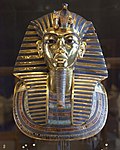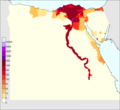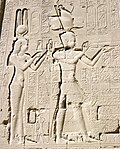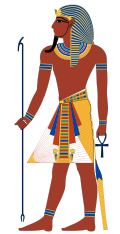Portal:Egypt/Selected picture
Tools
Actions
General
Print/export
In other projects
Appearance
From Wikipedia, the free encyclopedia
-
Image 1Rectangular fishpond with ducks and lotus planted round with date palms and fruit trees, Tomb of Nebamun, Thebes, 18th Dynasty (from Ancient Egypt)
-
Image 2Egyptians celebrated feasts and festivals, accompanied by music and dance. (from Ancient Egypt)
-
Image 6Tutankhamun's burial mask is one of the major attractions of the Egyptian Museum of Cairo. (from Egypt)
-
Image 8Naguib Mahfouz, the first Arabic-language writer to win the Nobel Prize in Literature (from Egypt)
-
Image 9Graphic of the increase in temperature in Egypt overtime (from Egypt)
-
Image 11The Rosetta Stone (c. 196 BC) enabled linguists to begin deciphering ancient Egyptian scripts. (from Ancient Egypt)
-
Image 14Arabic calligraphy has seen its golden age in Cairo. This adornment and beads being sold in Muizz Street (from Culture of Egypt)
-
Image 16Egypt's population density (people per km2) (from Egypt)
-
Image 17Smoke rises from oil tanks beside the Suez Canal hit during the initial Anglo-French assault on Egypt, 5 November 1956. (from Egypt)
-
Image 18Ruins of Deir el-Medina (from Ancient Egypt)
-
Image 19Soad Hosny, Egyptian film star. Among the most famous Egyptian and Arabic actresses. (from Culture of Egypt)
-
Image 22The Giza Necropolis is the oldest of the ancient Wonders and the only one still in existence. (from Egypt)
-
Image 23Celebrating the signing of the 1978 Camp David Accords: Menachem Begin, Jimmy Carter, Anwar Sadat (from Egypt)
-
Image 24Aziz Pasha Abaza, poet from the aristocratic literary Egyptian family the House of Abaza of Circassian Abazin origin (from Culture of Egypt)
-
Image 25The central business district in Egypt's under construction new administrative capital (from Egypt)
-
Image 26Egyptian literacy rate among the population aged 15 years and older by UNESCO Institute of Statistics (from Egypt)
-
Image 27The pyramids of Giza are among the most recognizable symbols of ancient Egyptian civilization. (from Ancient Egypt)
-
Image 28Egypt's topography (from Egypt)
-
Image 29Painted limestone relief of a noble member of Ancient Egyptian society during the New Kingdom (from Ancient Egypt)
-
Image 30The Temple of Dendur, completed by 10 BC, Metropolitan Museum of Art (New York City) (from Ancient Egypt)
-
Image 32The Cairo Metro (line 2) (from Egypt)
-
Image 33The Book of the Dead was a guide to the deceased's journey in the afterlife. (from Ancient Egypt)
-
Image 35Ancient Egyptians playing music (from Egypt)
-
Image 37Frontispiece of Description de l'Égypte, published in 38 volumes between 1809 and 1829 (from Ancient Egypt)
-
Image 38The Ptolemaic Queen Cleopatra VII and her son by Julius Caesar, Caesarion, at the Temple of Dendera (from Egypt)
-
Image 41The pharaoh was usually depicted wearing symbols of royalty and power. (from Ancient Egypt)
-
Image 42Pharaohs' tombs were provided with vast quantities of wealth, such as the golden mask from the mummy of Tutankhamun. (from Ancient Egypt)
-
Image 45Napoleon defeated the Mamluk troops in the Battle of the Pyramids, 21 July 1798, painted by Lejeune. (from Egypt)
-
Image 48The well preserved Temple of Isis from Philae is an example of Egyptian architecture and architectural sculpture. (from Ancient Egypt)
-
Image 49Tourists riding a camel in front of Pyramid of Khafre. The Giza Necropolis is one of Egypt's main tourist attractions. (from Egypt)
-
Image 50Early tomb painting from Nekhen, c. 3500 BC, Naqada, possibly Gerzeh culture (from Ancient Egypt)
-
Image 51The preserved Temple of Horus at Edfu is a model of Egyptian architecture. (from Ancient Egypt)
-
Image 54Four colossal statues of Ramesses II flank the entrance of his temple Abu Simbel. (from Ancient Egypt)
-
Image 55Lower-class occupations (from Ancient Egypt)
-
Image 56The Al-Hakim Mosque in Cairo, of Al-Hakim bi-Amr Allah, the sixth caliph, as renovated by Dawoodi Bohra (from Egypt)
-
Image 57Wooden figures of soldiers, from the tomb of nomarch Mesehti (11th dynasty) (from Ancient Egypt)
-
Image 59Anubis, the god associated with mummification and burial rituals, attending to a mummy (from Ancient Egypt)
-
Image 61Measuring and recording the harvest, from the tomb of Menna at Thebes (Eighteenth Dynasty) (from Ancient Egypt)
-
Image 63Coffin of Khnumnakht in 12th dynasty style, with palace facade, columns of inscriptions, and two Wedjat eyes (from Ancient Egypt)
-
Image 64Statues of two pharaohs of Egypt's Twenty-Fifth Dynasty and several other Kushite kings, Kerma Museum (from Ancient Egypt)
-
Image 66Change in per capita GDP of Egypt, 1820–2018. Figures are inflation-adjusted to 2011 International dollars. (from Egypt)
-
Image 69(from Egypt)Governorates of Egypt1. Matrouh2. Alexandria3. Beheira4. Kafr El Sheikh5. Dakahlia6. Damietta7. Port Said8. North Sinai9. Gharbia10. Monufia11. Qalyubia12. Sharqia13. Ismailia14. Giza15. Faiyum16. Cairo17. Suez18. South Sinai19. Beni Suef20. Minya21. New Valley22. Asyut23. Red Sea24. Sohag25. Qena26. Luxor27. Aswan
-
Image 71The Edwin Smith surgical papyrus describes anatomy and medical treatments, written in hieratic, c. 1550 BC. (from Ancient Egypt)
-
Image 74The Fayum mummy portraits epitomize the meeting of Egyptian and Roman cultures. (from Ancient Egypt)
-
Image 75A figure wearing the red crown of Lower Egypt, most probably Amenemhat II or Senwosret II. It functioned as a divine guardian for the imiut; the divine kilt suggests that the statuette was not merely a representation of the living ruler. (from Ancient Egypt)
-
Image 77Al-Azhar Park is listed as one of the world's sixty great public spaces by the Project for Public Spaces. (from Egypt)
-
Image 80Egyptian honour guard soldiers (from Egypt)
-
Image 82Egypt under Muhammad Ali dynasty (from Egypt)
-
Image 83The halls of Karnak Temple are built with rows of large columns. (from Ancient Egypt)
-
Image 86Glassmaking was a highly developed art. (from Ancient Egypt)
-
Image 87The gods Osiris, Anubis, and Horus in the tomb of Horemheb (KV57) in the Valley of the Kings (from Ancient Egypt)
-
Image 89Hunting game birds and plowing a field, tomb of Nefermaat and his wife Itet (c. 2700 BC) (from Ancient Egypt)
-
Image 91Protesters from the Third Square movement, which supported neither the former Morsi government nor the Armed Forces, 31 July 2013 (from Egypt)
-
Image 94An offshore platform in the Darfeel Gas Field (from Egypt)
-
Image 95A tomb relief depicts workers plowing the fields, harvesting the crops, and threshing the grain under the direction of an overseer, painting in the tomb of Nakht. (from Ancient Egypt)
-
Image 96Muhammad Ali was the founder of the Muhammad Ali dynasty and the first Khedive of Egypt and Sudan. (from Egypt)
-
Image 102Seagoing ship of an expedition to Punt, from a relief of Hatshepsut's Mortuary temple, Deir el-Bahari (from Ancient Egypt)






























































































